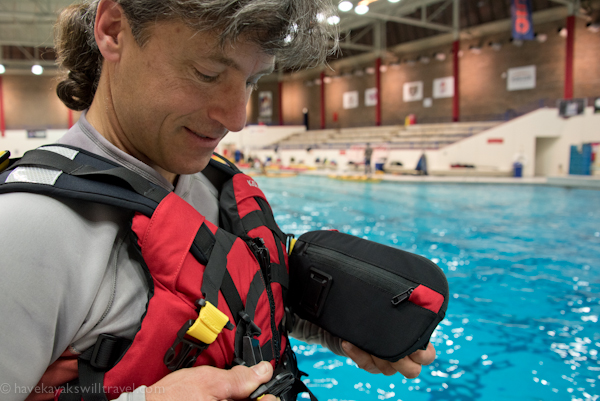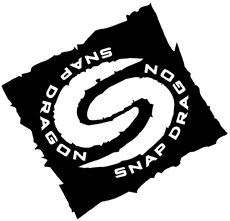For years, we’ve hunted for the perfect PFD. “Perfect” depends on your size and body shape, of course, as well as the type of paddling you do, so we resigned ourselves to the idea that we might have to own more than one.
We have long used the Kokatat MsFit Tour for sea kayaking. It fits our smaller frames better than most PFDs and has enough pockets to store the essential kit we want when we coach or guide. Last year we started wearing the Kokatat Maximus Prime Rescue PFD for our river paddling. We really like the interlocking, moveable floatation panels that tighten down to conform to our bodies, an even more unrestricted cutout for our arms, and the padded shoulder straps that make carrying a boat on your own as comfortable as it could ever be. This ultra-comfortable PFD is designed for whitewater and has a single generous chest pocket. We wondered if we could use it for sea kayaking. Disappointingly, no. There just isn’t enough pocket space for the essentials needed for coastal paddling.
So when we heard that Kokakat had developed a new PFD with many of the same features as the Maximus series, but for sea kayakers, we had to check it out. (In full disclosure, we are Kokatat ambassadors, but we use and recommend what really works best for us and our students.)
What follows is our initial impression based on using the Poseidon in pool sessions. We intend to give it a thorough trial in open water when our ice melts this spring and will update this review.
The vest is compact and can be cinched down horizontally with three straps on the right and left, and vertically with two straps at your stomach. It has the arm clearance of the Maximus, along with the foam that wraps around the side, providing added protection. The wide shoulder straps have neoprene padding. It fits smaller torsos well and is very comfortable.
Probably the most innovative aspect of the Poseidon is its modular design, which allows you to customize it in numerous ways. A series of straps across the front allows you to attach three zippered pockets, a radio holder and a quick release belt. On the back, you can attach the traditional tributary hydration system or the new tactic pack (more on that later), or you can simply stow the 1.5 liter Hydrapak in a built-in sleeve in the PFD. You can use the whitewater-style quick-release belt, or add a tow tether. All front pockets are attached with “slick clip” connectors on one side, which are designed to release under 75 pounds of force (so you can’t get entrapped if a pocket snags on something, for example during a rescue ). The other side of each pocket uses Fastex connectors to allow you to quickly detach one side for access to the back of the pocket or the vest beneath the pocket.

The tactic pack holds a hydration bladder and has room for other kit in two zippered pockets. Unclip one side, and it swings to the front of the PFD for easy access.
With so many options, we set out to answer the following questions:
- Can this system accommodate everything we carry while sea kayaking?
- If so, what configuration of accessories would accomplish this?
- Would the bits and pieces get in the way during rescues?
- Is the system too bulky or too complicated?
We can answer our first question easily: yes. It allows you to store as much or as little as you like. It can take some time to figure out which pockets you will need and where to attach them. (Check out this video for a helpful overview.) We started by trying just the full chest pocket on the upper chest. This provided as much storage as the Maximus for river paddling, but not enough for our sea kayaking kit. We then added the belly pocket. This brought the total pocket space up to the level of the MsFit Tour, and it didn’t feel too bulky.
We then added the tactic pack, which can hold a hydration bag ( and/or more kit) and has two additional zippered pockets on the inside. You can reach these pockets by unclipping two Fastex connectors on the right side and swinging it around for easy access. Pretty neat! Our question is how this will work in practice on the water. It’s a little tricky to get the pack back into position to reconnect the fasteners, and we don’t think we would want to be doing that in rough conditions. The solution would be to store only items you wouldn’t need in rough conditions, in which case it becomes an annex to the day hatch (and we’d rather carry that type of kit in our boats than on our bodies). We also found that placing a full hydration bag in the tactic pack and wearing two full front pockets made this vest pretty bulky, so it’s a good idea to think about how much to carry and where you’ll store it.
The Poseidon accommodates a quick release belt for use with the Touring Tow Tether or the River Tow Tether. We really like how compact and easy to deploy the river tow tether is, and we plan to explore using it in addition to our North Water Dynamic Tow Line.
Impressions: The Poseidon is a very comfortable sea kayaking PFD that fits well on a smaller, shorter torso. It has the quality materials and workmanship you’d expect from Kokatat. Even when filled completely, the chest pockets don’t inhibit mobility. The tow tether is easy to deploy and release, though like all tow systems, it requires some practice.
The Poseidon does take more time to put on and adjust because there are more connections to make and there are more straps to keep track of (we will need to spend more time with it to see if these cause confusion in conditions). That said, it allows paddlers to individualize the many options.
Because this vest is modular, the cost depends on the options you choose. The vest itself costs $159, and includes the full chest pocket with three zippered compartments and a knife lash tab. The expedition kit, which includes the tactic pack, a belly pocket, a reservoir and a quick-release belt, costs another $135. Other accessories can be added for an additional cost.
If you’ll be at Canoecopia next weekend or any place where you can try out this new PFD, check it out.











hey did you get a look at the stitching and shoulder strap materials? is it reinforced for ww rescue as well as SK
thanks!!
oh and other colours?
Shawn
Hi, Shawn. It isn’t a whitewater rescue vest, so it doesn’t have a harness system to distribute the load as you’d need in a whitewater rescue situation, and Kokatat is very clear about this being the case. It’s available in yellow, too. — Alec and Sharon
I just bought this vest. It is extremely comfortable and has a pocket for everything I need. Getting the hydration pack to the front takes some practice but I am willing to practice….alot. lol . I think I will be very happy over the years with this vest.
Jo Ann, that’s great and thanks for the feedback. We would love to hear your impressions as you sue it more.
We just returned from a trip where Alec used the Poseidon both for canoeing as well as sea kayaking. The two front pockets did provided enough space that he didn’t use the tactic pack on the rear and instead put the hydration pack in the built in sleeve on the rear of the pfd. He did like the mobility, and is looking forward to testing it in rescues and a variety of conditions.